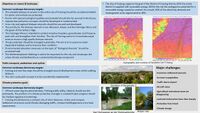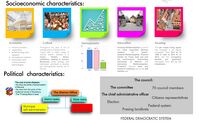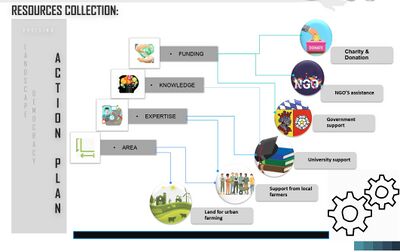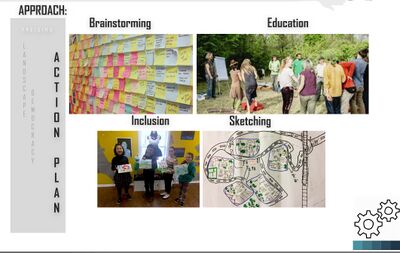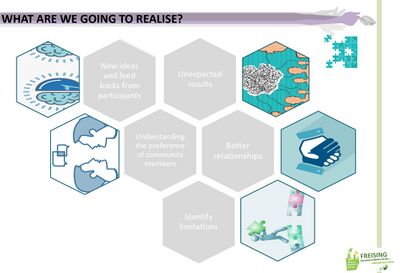LED2LEAP 2020 - Freising Team 5
>>>back to working groups overview
| Area | Freising | |
| Place | Freising and Munich Airport area | |
| Country | Germany | |
| Topics | Landscape Democracy | |
| Author(s) | Aida Kadic,Krishna Ambali Parambil,Imad Eddine Lallouche and Zareen Kashfee Prianka | |

| ||
Landscape Democracy Rationale
- This community context is relevant from a landscape democracy perspective because it is situated in a developed nation which is governed by democratic system and preserve the right of freedom of speech.It is also a basic social unit where there are many common aspects or attributes that makes it easier and effective context to have analysis on the landscape democracy.We can find out information about a particular space,their thoughts and needs about specific things and based on which we know how to mange green and urban areas.
- Our hypothesis is that from the challenge we have derived that the community of Freising is to a large extent familiar with the challenges they are facing and quite successful in stopping the things they don't support (e.g.the third runway of the airport).Community members are more concerned about the climate changes issues and have a futuristic vision.
Location and scope
- Map of Location
Phase A: Mapping our Community
The cityscape of Freising is shaped by the location of the city on the tertiary edge of the hill, to the south is Munich Gravel Plain, and extends north to the Tertiary hill country. The following striking elements shape the cityscape:
- The Domberg and the Weihenstephaner Berewry
- The green slopes
- The rivers
- Munich airport.
- The old town and the historic city and Town centers
- Neustift, Weihenstephan or Vötting
- the prince-bishop's residence
- A moderately growing population.
- Lower rate of unemployment and a thriving prospect.
- Multi-sources of income for the landkreis of freising.
- Breathtaking forests.
- Rich culture and diverse ethnicity.
- a beacon for scientists and future brewers.
- Reminiscent city with many historical landmarks
.
Groups of actors and stakeholders in our community
- Which groups/sub-communities are there? What are their needs and aspirations with regard to the landscape? Which groups are more visible? Which are less visible? What do we not know? (max 200 signs)
- Primary external stakeholders(Government bodies, moderators and decision makers)
- Private external stakeholders(Banks, Hotels, Private health institutions....)
- Community local stakeholders(landlords, farmers, investors,scientists......)
- Non profit internal stakeholders( churches, sports teams, parents groups....)
- Individuals(children, parents, disabled people....)
- the list of the Groups that are more visible includes( Officials, politicians, farmers, scientists,environment department representatives)
- Groups that are visible ( Investors,landlords, university, manufacturing organizations..)
- the remaining groups are less visible
- the needs and aspirations of the community: sustainable green city, reducing pollution and traffic jam, global warming issue and reducing co2 emission, airport noise, against the 3rd runway project of the airport.
- What we do not know:
- The strategies that has already been adopted to counteract wicked problems and the district's regulations.
- We also need to interact directly with people in order to have an in-depth understanding of the community
Relationships between our actors and groups
- How to describe the power relationship between the groups?
- Which groups may have shared interests and which are these?
- The council and the committees including the district administrative officer are the decision makers.
- the decision makers are elected by citizens.
- All community members have shared interests, skills and common challenges.
- Government officials and airport representatives have a common vision.
- Community members have a conflicting interests with local officials.
Summary of our learnings from the transnational discussion panel on April 22
- Different approaches about storytelling
- Some groups had a smaller scale focus areas but more detailed analysis.
- We loved the presentation styles from the other groups and we got inspired with new ideas.
- Other value schemes: any surprises?
- We had a lot of information so the comment was to highlight the most important points.
Theory reflection
- From The Right to The Landscape- we have encounter the idea of landscape having different meaning to different person. It is not only a goal or movement but it is also a context of combining socio-cultural and natural aspects with the spiritual prerequisite of individual and resulting into the both physical and spiritual welfare of them. It is formed by negotiating and influencing the public’s need and it is a combination of work of nature and man.
- From The Just City Essays- this material reflected that there is no boundary between people,and between landscapes.We should works as a whole with few philosophies such as equity, choice, access, innovation, ownership, etc. it makes us aware of that everyone’s decision is important as well as the democratic parties and we should not have any border or discrimination while designing as the place belong to the individual living there. So every voice should be count to make something livable.
- From the Storytelling, a model of and a model for planning- we have come across the process of how stories grow together and nurture the landscape planning and development. It shows how the old one follows the present and then the future like a chain of cycle and it is a process of time and hardship with commitment of previous stories. It reflected how a landscape can develop keeping the past essence and thinking of the future along with the needs of the present.
References
- References
https://archiv.ub.uni-heidelberg.de/propylaeumdok/498/1/06_09_rodier_et_al_urban.pdf, https://storymaps.arcgis.com/stories/dfa1ad422e8e49cf8293a7d0082d5d81 https://www.tripadvisor.com/LocationPhotoDirectLink-gi-Braustuberl_WeihenstephanFreising_Upper_Bavaria_Bavaria.html https://docs.google.com/forms/d/1lpQqRCZyAuTNvLm7RYwYWcy2L4TqW-nEf_Tcykfb04Q/edit?ts=5e9c5e36 https://storymaps.arcgis.com/stories/dfa1ad422e8e49cf8293a7d0082d5d81 https://weatherspark.com/y/70416/Average-Weather-in-Freising-Germany-Year-Round https://www.kreis-freising.de/englisch https://en.wikipedia.org/wiki/Freising_(district) http://www.icos-infrastruktur.de/en/icos-d/jahrestreffen/2019-freising/ https://www.greenaironline.com/news.php?viewStory https://www.freising.de/media/user_upload/61_Stadtplanung_Umwelt/6110_pdf-Files/STEP/stadtentwicklungsplan-step-2030-freising http://neighborhoodeconomics.org/community-stakeholders/
Phase B: Democratic Landscape Analysis and Assessment
The Scene in your Story of Analysis
- We already know that the third airport runway project was faced with public outrage. Community members, activists, artists brought hands together, voted, and protested all against this project so our main challenge is to reduce the shearing and the ever-expanding gap between politicians and the locals.
- The second main challenge is to integrate immigrants, students, and refugees with the local community through a participative initiative so as to know all community members' aspirations and try to respond back and improve the landscape.
- Sharing values and taking advantage of community members’ skills and talents. Making the community more sensitive and aware of landscape issues.
- The physical scenes are the Marienplatz square, the Beer Garden, the weihenstephen university & the urban foodscapes.
- The socio-economic characteristics are Economy, Culture, Demography, Education & Housing.
- The political characteristics of the place are the council,70 council members, Citizens representatives,Fresing landkreis,& Federal system.
The Actors in your Story of Analysis
- In our story we won’t give any one a major role aside from farmers and landscape experts who would guide the community through the entire process.
- All the remaining members have the same roles and tasks so as to achieve social equality amongst all of them and enable them to walk in one another’s shoes. The less visible members in the community would also realize their importance and the fact that they are as equal to anyone in the group.
The Story of Analysis
- Our story begins with the idea of creating heaven before afterlife with love, sharing , humanity , equality , participation, and nature. To create this heaven we decided to gather all the stakeholders and citizens of all ages together to create a foodscape together. We used the different skills of the individual in this process.
- Before grouping a few steps are followed like- 1. Budgeting from churches, mosques, nonprofit organizations, and volunteer donations. 2.Advertising for examples-postering, brochures, and digital advertising using social media. 3. Signing up for the program/workshops. 4. Purchasing plants, crops, seeds with experts, scientists, and florists help and advice.
- Our groups were diversified and people in each group should be given equal opportunities to speak and to express himself. No moderators. University IT students also contributed by creating a smart application that would assist the volunteers to expand their knowledge and use this application efficiently. Each group should be given a tablet and the application can be shared and used on mobile.
- Then all together making a sense of their skills and talents for example farmer and others planting trees, experts monitoring them, painter painting the event in their canvas and musicians or singers playing their tune and building the foodscape and environment together. After making the foodscape they cook, eat, dance, and express themselves together by drawing a mural on a wall near the place and putting paper scribbles with their ideas and experiences or feelings of the day.
- The way they perceive the Future Changes through the Present Experiences will remain an Unforgettable souvenir and the Success Story to be narrated to the Future generations!
Reflect on your Story of Analysis
- The tools we chose for landscape analysis fit our community well as it helped us to gather every individual and which helped them to experience each others' visions and skills. Our method will have a long term on people’s mindsets as it motivates them, empowers them, and makes them contributors as role models in society. The story they made together will reincarnate from those scribbles on the paper stickers and on the mural they draw together.
- Our Story delves deep in the community’s issues and phase A provided us with an overall idea about the community Of our study. In phase A we were about to identify the social composition, what sets apart the culture, socio-economic And spatial characteristics, stakeholders, and the relationship between them and define the challenges and highlight the aspirations and goals of the community. In Phase B we were able to use the information gathered previously and build on it our story the would be the backbone of our design process.
- We were carrying the skills of different individuals and the community together with their conflicts too. We carried it because to reduce the conflicts and to create an understanding of the visions each of them has by walking in each other's shoes. We tried to carry it with LOVE, EQUALITY, HAPPINESS, VALUES, SHARING, PARTICIPATION & NATURE.It leaves behind all the memories they have created together and the bonds among them having a print for the future generations.
Phase C: Collaborative Visioning and Goal Setting
The Scene in our Story of Visioning
- From the phase A analysis we have come up with many challenges for the community of Freising and the main challenge that we worked on in phase B is the conflicts between the stakeholders and their difference in visions. In this phase, the challenge is the same as before and here we have new goals and visions.
- the transformation process includes collecting aspiration from the community, storytelling and having new ideas. Then participation and transaction of the stakeholders and at last the action plan and its implementation.
- This process should go through different steps and rely mainly on creativity and this is why it is extremely important that the process should be inclusive and gives equal opportunities to all participants to express their point of views.
The Actors in our Story of Visioning
- People of different social groups and age groups actively participating in the onsite activities.People with different professions and status in society, such as doctors, experts, students, farmers, etc. There should be no moderator in this process.
- Team of young journalists, refugees, local family, tourists, politicians, local children, and team of landscape experts will be the main actors of our community and the scene takes place on the lands for urban farming in the city.
The Story of Visioning
- Participating for the sake of Planting the Tree that would ensure a better future prospect for the children. Starting with the collection of resources like funding, knowledge, expertise, and land. For funding, we are taking help from the NGOs, government, and donations.for knowledge the university researchers and students would help and also for expertise and land include the local farmers. This would take us maybe one year to get approved from different sectors and according to the laws.
- After that, we start advertising through different means to gather the community and the actors together. For better participation, students in the IT field would do their contribution by developing apps with different functions for the community. Our groups should be diversified and each person in the group has a different opinion and skills. No one in each group should have a superior authority than the other members. People can equally contribute by expressing their opinions, visions, and sharing their skills. This is done through the process of brainstorming, educational workshops, inclusiveness of the stakeholders, and later on sketching the ideas on the paper.
- There are lands for leasing in Freising that could be used for food urban production. For community members who are aiming at improving the local urban landscape. Urban farming could be an ideal way to bring people together side by side, communicate efficiently, walk in one another’s shoes, and come up with new ideas. For the final year, developing urban farming together would be the best possible way to reach our goal and the actors can eat, cook, laugh together reducing their conflicts, and sharing their views and perception for better future development.
Reflect on our Story of Visioning
- The most important when formulating goals are participation rate, crop yields, long term urban farming, the improvement of the quality of the urban landscape, people’s impression, mitigating the conflicts, and bridging society members.
- The common characteristics of a good vision-
Powerful visions must draw people, attract them, make them want to take action and overcome obstacles to achieve it. It must feel worth achieving, worth putting real effort into getting there. Visions need to include the interests of the possible community in a way that everyone can see their value and can support them. There must be a balance between having visions that are seen to be achievable, and that also challenge and stretch people. A vision must be readily communicated and understood by a broad range of people.
- From our story of vision we have learned about the community and its people and their relationship and visions.we have come across the landscape benefits and its effect on the community and the ways to minimize the conflicts by engaging the whole community.
Phase D: Collaborative Design, Transformation and Planning
Our Prototyping Action
- What was our prototyping action? What does it represent and how does it relate to your vision from Phase C?
The Evolution of our Prototyping Action
- Describe the actors who were working together on this action. What was your collaborative design process? What tools or methods did you use to collaborate?
The Plan Behind our Prototyping Action
We thought of using a jigsaw as tool to implement our prototyping method because of its own dovetailing metaphoric shape. The dovetailing pieces represent in an abstract way the community stakeholders that are putting them together in our process. This can help them interact to exchange ideas and come with new ways of thinking far from their differences and conflicting interests. The jigsaw can also be very instructive just like a raster map that familiarizes the group members with the site they are designing together. The jigsaw puzzle is a very entertaining and enjoyable game as it creates a certain friendly and funny atmosphere.A jigsaw puzzle is also suitable for children as it improves their cognitive abilities.
- 1st step:
All the mixed groups can work together as One team to put the map together as an entertaining and ice-breaking way amongst all the participants. Here maybe children can play a major role in this as it helps them improve self-confidence and boost their cognitive skills
- 2nd step:
The colorful pins, wire threads, and needle It can be used to draw the perimeter of the areas concerned with urban foodscapes, orchards, and other types of land use. In this step, the role of the facilitators, planners, and cadaster officials can play a major role.
- 3rd step:
In this last step, groups can choose different areas, propose, discuss, and use what they learned previously in designing the use and the type of crops that need to be put in their focus areas. This can also include some other proposals, such us adding landscape features, bridges, and other activities they see that it is lacking the city.
The Realization of our Prototyping Action
- What happened, who was there and what was the atmosphere like among the participants?
Reflect on our Prototyping Action
- CHANGES MADE BY THE INTERVENTIONS
•Sense of shared ownership in the success of the project. •Better knowledge of the problems in the community and possible solutions. •Mitigating the conflicts and help the participants break the ice •Relationships between participant groups •Identify the missing parts •Understanding the importance of unity. •Attitude change on different aspects
- DIFFERENT APPROACH
•We make it effective by using interesting tools like jigsaw pieces, magnets, etc. •We give complete freedom for the participants throughout the activity •We let them realize themselves our goals and visions. •We pays attention to the confusion and conflicts among the participants throughout the activity. •Run a series of tests. •Embracing the failure
- REFLECTION OF INTERVENTIONS FROM PHASE D LECTURES
•We used the viral strategy from the previous lectures and literature of phase D •We used high fidelity model using a jigsaw, stickers, paper, pens, pins, thread…..etc •Our model can be considered a high fidelity prototype because we proposed a methodic, reliable source of information that can tell us what exactly the community wants. However, this prototype still needs some further experts’ research and adjustment.
- SUCCESS INDICATORS
Participation rate •Documenting all comments •Results of the final test •Satisfaction of participants •Improvement of the quality of the urban landscape •Simplicity of the intervention •Respecting ethics and participants’ choices •Motivation to carry out the design on ground-planting activity.
Phase E: Collaborative Evaluation and Future Agendas
Collaborative Evaluation and Landscape Democracy Reflection
- As the main challenge for our community was the conflicts between the stakeholders, the tools we chose for landscape analysis fitted our community well as it helped us to gather every individual and which helped them to experience each others' visions and skills. We were about to identify the social composition, what sets apart the culture, socio-economic And spatial characteristics, stakeholders, and the relationship between them and define the challenges and highlight the aspirations and goals of the community.
- For our community we used urban farming as the way to mitigate some of the conflicts which in turn help us to work on some of the sustainable development goals like -no poverty, zero hunger, reduce inequalities and sustainable cities and communities. Urban farming helped us to reduce and help to reach these goals providing better landscape, more food production, and community gathering.
The Actors in our Collaborative Evaluation
- People of different social groups and age groups actively participating in the onsite activities.People with different professions and status in society, such as doctors, experts, students, farmers, etc. There should be no moderator in this process.
- Team of young journalists, refugees, local family, tourists, politicians, local children, and team of landscape experts will be the main actors of our community and the scene takes place on the lands for urban farming in the city.
Reflection of the Online Seminar
- It was quite informative and interesting to know and learn new methods and tools. We learned and realized the sense of unity, coordination, and communication, the importance of knowledge and farming benefits.
- It had a bad impact because of many restrictions. Couldn’t meet the people representing different groups-no direct experience with the community- hard to coordinate works- personal problems because of a pandemic.Of course, there were troubles in the beginning as it took some time to understand the seminar- then later it went smoothly and could cope up.
Reflection of the Living Lab Process
- ’'How did COVID-19 affect the living lab and it’s activities. Were you and the community satisfied with them? What were the greatest outcomes, outputs and impacts of the project? What indicators did you use to evaluate them?’'
Our Living Lab Code of Conduct
- For setting value for ourselves, our team, the stakeholder, the landscape, and our community we used the mural exercise among our team and set four values/principals for each one of them. Then we came up with the main code of conduct for our living labs.
Process Reflection
- We learned as a group in terms of addressing a landscape democracy challenge that- There are many conflicts between the stakeholders, The power structure is biased, There are different groups in the community funding and financial assessment is difficult to carry out, The COVID 19 pandemic and its effects on the functioning of the activities, Importance of communication and coordination of events and meetings, Knowledge about the community members and their visions and demands for future developments.
- One lesson learned by each individual team member- Sticking together as a team, Being patient and listen to others, Respecting each others’ visions and importance of teamwork.
- The most important next step or action for our Living Lab- •We form a team of volunteers who can sustain the living lab and its activities by correcting the mistakes and improving the activities to retain the result and make it better over the years.•We will make it effective by using interesting tools like jigsaw pieces, magnets, etc. •We will give complete freedom for the participants throughout the activity •We will let them realize themselves our goals and visions. •We will pay attention to the confusion and conflicts among the participants throughout the activity. •Run a series of tests. •Embracing the failure.





